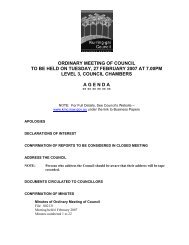Ku-ring-gai Heritage Conservation Areas North Inventory Sheet
Ku-ring-gai Heritage Conservation Areas North Inventory Sheet
Ku-ring-gai Heritage Conservation Areas North Inventory Sheet
Create successful ePaper yourself
Turn your PDF publications into a flip-book with our unique Google optimized e-Paper software.
<strong>Ku</strong>-<strong>ring</strong>-<strong>gai</strong><br />
<strong>Heritage</strong> <strong>Conservation</strong> <strong>Areas</strong> <strong>North</strong> <strong>Inventory</strong> <strong>Sheet</strong><br />
Sheddon Adam for his sister; Egelabra at 70 <strong>Ku</strong>-<strong>ring</strong>-<strong>gai</strong> Avenue was designed by Thomas Cosh of<br />
Spain & Cosh architects.<br />
Notable inter-war period to 1940s houses are: 71 <strong>Ku</strong>-<strong>ring</strong>-<strong>gai</strong> Avenue, designed by architect F. Glynn<br />
Gilling of the firm Joseland & Gilling as his parents’ retirement house; and Oakburn, 5 Womerah<br />
Street, designed by Professor Leslie Wilkinson in 1940.<br />
Resubdivision of many of the <strong>Ku</strong>-<strong>ring</strong>-<strong>gai</strong> Avenue and Womerah Street properties occurred in the<br />
1960s, often resulting in battleaxe allotments. Most of these battlexe alotments contain newer<br />
housing, however some retain older houses: the battleaxe alotment at 75 <strong>Ku</strong>-<strong>ring</strong>-<strong>gai</strong> Avenue<br />
contains the house Chasecote designed by architect Arthur Stanton-Cook. circa 1906; another, at 41<br />
<strong>Ku</strong>-<strong>ring</strong>-<strong>gai</strong> Avenue, contains an interesting Inter war mediterranean style house. Another alotment<br />
created in the 1960s, 3 Womerah Street, contains the Creaser Residence desiged in 1962 by<br />
architect Peter Muller.<br />
The area was classified by the National Trust as the <strong>Ku</strong>-<strong>ring</strong>-<strong>gai</strong> Avenue Urban <strong>Conservation</strong> Area in<br />
1984.<br />
There is a significant avenue of mature brush box trees lining <strong>Ku</strong>-<strong>ring</strong>-<strong>gai</strong> Avenue, possibly the work<br />
of the Wahroonga Progress Association which undertook a beautification program of street tree<br />
plantings in the area.<br />
Womerah Street: spectacular and highly significant remnant blue gum high forest trees as street<br />
trees. Large mature gardens obscure houses. Blocks frequently feature hedging rather than front<br />
fences. There is soft edging along most of the street.<br />
<strong>Ku</strong>-<strong>ring</strong>-<strong>gai</strong> Avenue from No. 26 (corner Womerah Street) to north: wide street, mature brush box<br />
street tree planting interspersed with jacarandas. Concrete kerbing both sides, and large mature<br />
gardens surround substantial houses.<br />
<strong>Ku</strong>-<strong>ring</strong>-<strong>gai</strong> Avenue from corner Womerah Street to the Pacific Highway: mixed mature brush box<br />
and jacarandas as street tree planting. Concrete kerbing both sides, Large mature gardens to<br />
substantial houses.<br />
Boomerang Street: from Bobbin Head Road to <strong>Ku</strong>-<strong>ring</strong>-<strong>gai</strong> Avenue: mature street tree plantings on<br />
both sides, concrete kerbing both sides, elaborate stone front fencing of the large site of the house<br />
Ingleholme at No. 17 on the north side, relatively high hedges and masonry front fences. Relatively<br />
busy street with considerable local through traffic.<br />
Built Character: A predominance of fine substantial 2 storey late 19th century and Federation period<br />
mansions, the majority in the Federation Queen Anne style, on large lots with large mature gardens,<br />
interspersed with a smaller number of later 1 and 2 storey houses, frequently also high quality<br />
architect-designed housing of their period. The overall visual impact of the area is as high-quality<br />
Federation period streetscapes, including Federation period street tree planting, and mature<br />
gardens.<br />
The buildings from the key periods of significance for the area - Federation period 1890s-1914, and<br />
the Inter war period are predominantly brick with slate or terracotta tile roofs and timber-framed<br />
windows. Later housing is frequently rendered brick or non-traditional (e.g.. blond) brickwork, with<br />
concrete tiled roofs. Traditional front fencing is generally timber picket, brick, cast iron palisade or<br />
sandstone. Front fences to later houses are frequently high timber lap & cap or brush fencing,<br />
however many later houses have no front fences.<br />
KU-RING-GAI HERITAGE CONSERVATION AREAS NORTH INVENTORY

















